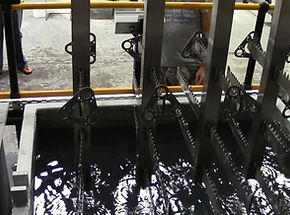top of page
Phosphating
Phosphating


Phosphate Coatings
Phosphate coatings are “conversion
coatings.” Unlike plating processes, in which a layer of metal is deposited on the surface of the substrate, during the phosphating process the substrate participates in the reaction and becomes a component of the coating.
The surface of the metal is chemically changed to a new structure that provides a porous, yet corrosion resistant surface to which the rust inhibitors, oils, paints, or other lubricants can penetrate and attach. The attachment site and absorption area are far superior to the base metal.
Phosphate coatings are formed from an interaction with the surface of the metal. Therefore, the thickness of the coating is dependent upon the porosity of the coating it forms. Once the phosphate coating foams and the surface of the substrate is completely sealed off from the phosphating solution, the chemical reaction ends. The resulting surface is a non-metallic crystalline coating containing iron, zinc, and/or manganese. Our phosphate coating is applied by an immersion processes.
What does Phosphating mean?
Phosphating is the process of converting a steel surface to iron phosphate. This is mostly used as a pretreatment method in conjunction with another method of corrosion protection. A layer of phosphate coating typically includes iron, zinc or manganese crystals.
Phosphating is also known as phophatizing and phosphate conversion coating.
Phosphate Coating Processes
-
Cleaning of Surface
-
Rinsing
-
Surface Activation
-
Phosphating
-
Rinsing
-
Drying
-
Ferrocoat (Optional)
bottom of page




